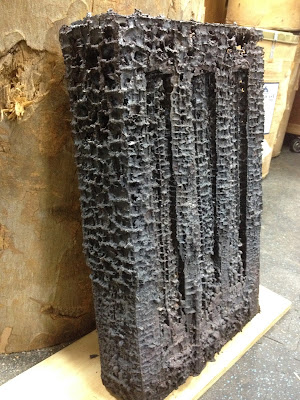“Irrational
Insecurity Module”
Bronze, Garnets
15”H
x 2”W x 1”D
2016



This new art jewelry necklace features a cast-bronze bat with bead-set 3.5mm faceted garnet eyes on a 24"chain fabricated from cast-bronze scale model units and bronze findings. This piece began its journey several years ago while still in grad school when the bat casting was first conceived and executed. The dead bat was found dried up and perfectly preserved in an attic, and was sealed with acrylic spray and the thin and delicate structures supported and built up with wax to ensure a successful casting. During the investment process, it appears that the acrylic spray did not completely seal the fur and skin of the dead bat, resulting in investment getting inside the bat. The unintentional consequence of this accident was that much of the skeletal structure of the bat became viable in the final bronze casting upon de-vesting and cleaning, in particular the shoulder-blades, spine, and pelvic bones. Once again, I only had one such bat casting, and the indecision of how to properly utilize such a unique piece prevented me from doing anything at all.
Years later, I was able to fabricate a bronze chain from other bronze cast elements I previously made, and went looking for a unit or element that would properly complement its aesthetic. The bat casting was finally brought out, properly finished and turned into a pendant, and was mounted onto the chain, which was then polished and given a dark patinea with hand-rubbed bronze highlights. The piece existed in this state for several weeks, as I would pick it up, inspect it, and put it back down, never quite sure what exactly kept bringing me back to it. Finally it occurred to me that the piece, while successful in form and structure, was missing some visual and contextual element of detail that would bring all the elements together and make the piece more interesting to the viewer and wearer.
This led to the setting of 2 3.5mm round brilliant-cut garnets into the empty eye sockets of the bat casting, which was a surprisingly difficult and tricky procedure due to the angles and geometry of the setting. What would ordinarily be a simple procedure to use a setting bur to cut the seats for the stones became challenging due to the presence and location of the bat's ears and forearm structures. After struggling a good deal to make level, smooth, even bearings for the garnets, the stones were press-fit into place, a round graver was used to push burs of metal over the girdles of the stones, and a properly-sized beading tool was used to form the curls and bulges of metal into proper beads.
And with that, another successful piece properly considered and completed.

























